Subscribe to blog updates via email »
December 2023 Income Report (and 2023 review!)
To listen to an audio version of this report, join the Patreon »
December’s revenue was $6,631, up from November’s $5,157. Profits were $4,424, up from November’s $3,143.
This is also the last report of 2023. 2023’s revenue was $88,202, down from 2022’s $116,029. Profits were $56,722, down from 2022’s $69,262.

WANT TO WRITE A BOOK?
Download your FREE copy of How to Write a Book »
(for a limited time)
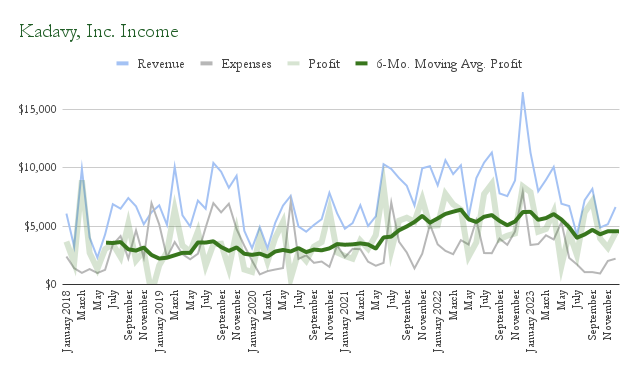
Monthly income normal, yearly income down
There’s nothing remarkable about this month’s numbers. Revenue and profits were about average for the past year. What is alarming is how much revenue and profit were down in 2023.
It’s not a big surprise if you’ve been paying attention to the reports this year. Book sales have been down a bit, I haven’t had good channels to make a profit with ad spend, and the one new book I introduced in the year – 100-Word Writing Habit – hasn’t sold great (though I may have a chance to turn it around – more on that later).
I do feel the temptation to panic, but when I look at the big picture, I think it’s best to keep my head down and finish the Getting Art Done trilogy.
2023 in review
Here’s a closer look at 2023’s numbers, relative to 2022.
| 2022 | 2023 | Difference | |
|---|---|---|---|
| Income | $116,023 | $88,202 | -$27,827 |
| Expenses | $46,767 | $31,480 | -$15,287 |
| Profit | $69,256 | $56,722 | -$12,540 |
That nearly $28,000 drop in revenue is 24%. That $12,000 drop in profits is 18%. This brings me back to about 2021’s numbers, when revenue was $92,253, and profits were $55,910.
This also brings me back below a couple significant psychological barriers: Revenues are now below that six-figure mark of $100,000 – the point at which I felt I had “made it” – and my overall earnings are below that “teacher’s salary” threshold of $60,000.
Category breakdown
Here’s how this breaks down across categories:
| Category | 2022 | 2023 | Difference |
|---|---|---|---|
| Book Sales | $87,555 | $65,907 | -$21,654 |
| Affiliates | $19,649 | $18,357 | -$1,292 |
| Digital Products | $4,278 | $1,593 | -$2,685 |
| Services | $1,871 | $207 | -$1,664 |
| Reader Support | $2,670 | $2,138 | -$532 |
The “Podcast” category has changed to “Reader Support,” meaning all this revenue is from Patreon. Given that I quit the podcast in August, it’s actually a good sign to me that revenue dropped “only” 20%. Presumably there’s still a good number of readers who want to support what I’m doing, even though I’m no longer publishing podcast episodes.
Services income dropped 89%. I had a paid speaking gig in 2022, which helped out there. I only had around $200 in income from Clarity calls in 2023. Perhaps raising my price per-minute affected that. Which could be good, as scheduling and conducting calls is a non-trivial interruption that justifies for me the price.
Digital Products income dropped by 63%. I’m actually surprised by that. I didn’t do much promotion of Digital Products, other than running a Black Friday sale, but that’s no different from 2022. My only explanations are: My courses are a year older, most who were interested already bought and maybe my audience didn’t grow enough to replace them, and/or people are just fatigued about online courses and not as interested.
Affiliate Income only dropped about 7%, which also surprises me, because I did essentially nothing to actively promote affiliate deals. ActiveCampaign was 78% of this revenue, and grew 5%. The Alliance of Independent Authors was about 18% of that revenue. Now that IngramSpark no longer charges for uploads of new books, the IngramSpark promo code that entices people to sign up for ALLi doesn’t seem as promising. However, I just realized ALLi members can get a BookVault promo code, so I’ve set up a page for that. ActiveCampaign has also been doing some sneaky things with their affiliate program that make me sense they’ll be cutting into that revenue – aside from the erosion of number of accounts I’ve referred.
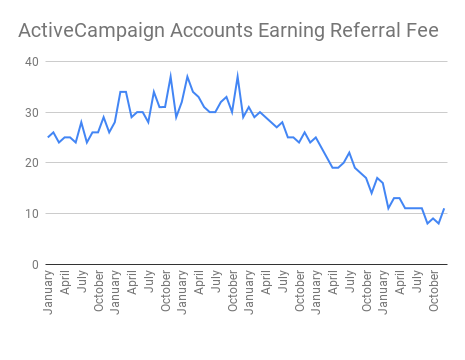
Book Sales is the biggest category by far, and its drop in revenue is pretty representative of the overall drop – about 25%. The most obvious way to make this number go back up is to release a new book. But I’m still a ways away from that. However, I still have plenty of books in my catalog to drive sales to, and I haven’t given up hope on getting those numbers back up before my next book. More on that later.
Higher profit margin. Changes in expenses.
Profits didn’t drop as much as revenue. Sales volume for books wasn’t as high in 2023 as 2022, but profit per unit was higher: $2.38 vs. $2.21, for MMT. Doesn’t sound like much, but that’s 7.7%.
This suggests I may have cut expenses somewhere. Indeed, I spent $835 less on accounting – I now do my own bookkeeping in Quickbooks. By not running the podcast, I spent $526 less on editing and software. But, I spent $260 more on hosting, probably from a combination of the Shopify store, running a couple live AMA’s through Riverside.fm, paying for Twitter Blue, and hosting my notes on Obsidian for a new offering for Patreon supporters.
The biggest drop in expenses was in Advertising. I spent $22,519 in Advertising in 2023, compared to $32,886 in 2022. That’s a drop of $10,367. In theory, I could have spent that money and made up for the $12,540 in lost profits. The resulting $22,907 in revenue would have brought my total revenue back to about the same level. That would have required about a 221% ROI on ad spend, which would have outpaced my average over the past twelve months of 180%. So, it doesn’t seem like a likely alternative outcome, but I probably could have spent more to make more.
What did I want to do in 2023?
Looking back at last December’s report, I was looking back at the previous December’s report, hoping I’d finish the final book in the Getting Art Done trilogy, in 2022.
Here I am at the end of 2023, and I’m still not done. Not even close. The irony of my struggles to finish Finish What Matters are not lost on me. Granted, I was only 60% sure I’d finish the manuscript before the end of the year, so I was only a little more than half wrong.
At moments, the project feels like it’s really gelling, and I’m on the “downhill” portion. At other moments, I feel as if I’ll never get it done, and I’m crazy to have ever thought I would.
In the meantime, with these lower revenues, I’m also reallocating some of my creative energy to figuring out how to revive revenues so I will worry less and focus more.
This time I’m 70% sure I’ll have the manuscript ready to be edited by the end of the year.
I also predicted I’d do more video in 2023. I did up-skill a lot in cameras, lenses, lighting, and Final Cut Pro. I was 50% confident I’d have at least 1,000 TikTok followers by the end of the year. I blew past that number, and now have more than 30,000.
I was 30% wrong that I’d have developed at least four new reels in the fourth quarter of 2023. After amassing millions of views on multiple reels, I burned out on TikTok, to focus more on the book. I am in the process of trying to get my bookstore approved for TikTok, so will probably revisit once I do.
Love Mondays Growth
My Love Mondays subscriber base has grown, and the rate of growth has been increasing over the years.
- In 2020, I lost 4.86% of subscribers
- In 2021, my subscriber base grew 3.85%
- In 2022, my subscriber base grew 10.59%
- In 2023, my subscriber base grew 17.6%
Here’s what that’s looked like over the years.
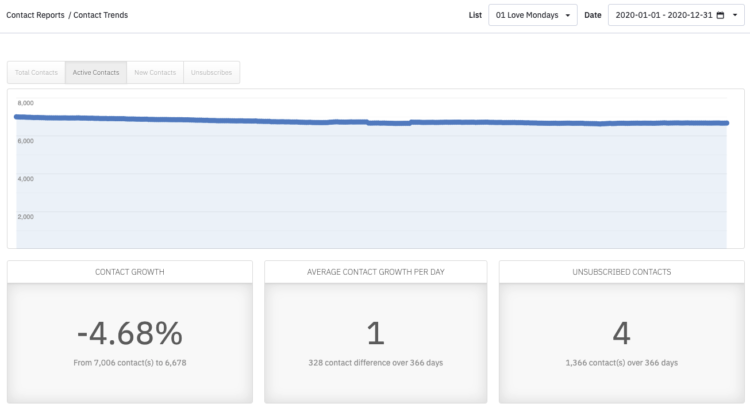
I lost 4.68% of Love Mondays subscribers in 2020.
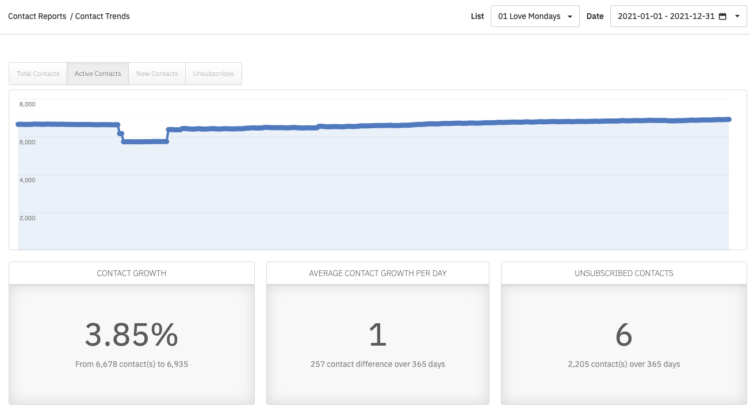
I gained 3.58% on Love Mondays subscribers in 2021.
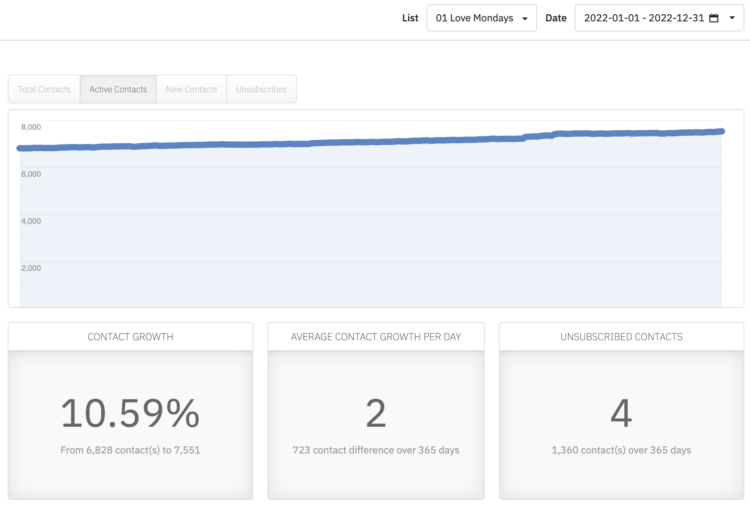
I gained 10.59% on Love Mondays subscribers in 2022.
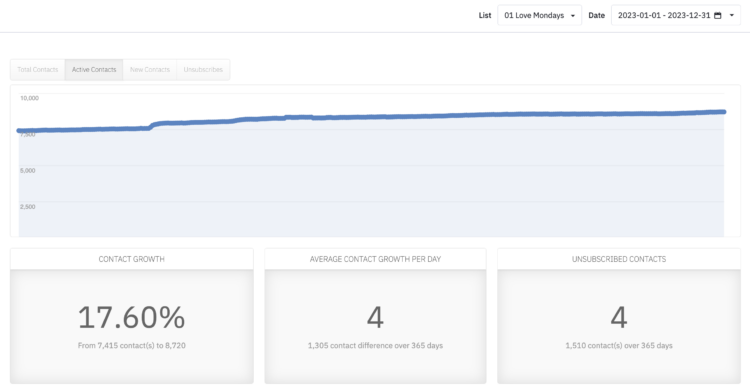
I gained 17.60% on Love Mondays subscribers in 2022.
In 2013, I grew my Design for Hackers subscriber base 6x in three weeks (from about 5,000, to about 30,000), so it feels strange to be excited about what was “only” a growth of 1,300 subscribers.
But it is growth, and I see the rate of growth increasing year after year. I like to think it means the existing subscribers of Love Mondays are enjoying the content, that they’re telling their friends, and that the system I’ve built for developing newsletters is helping it get a little better as time goes on.
Those can’t be the only reasons my rate of subscriber growth increased 66% this year. I did make some efforts to add more people to the list, by adding a more enticing lead magnet to pages here on kadavy.net. I even experimented for a while with growing the list through Meta ads. Maybe with my Shopify store up and running, I can better justify more ad spend that adds subscribers and converts to direct sales.
What do I want to do in 2024?
What would I like to do in 2024?
Of course, I’d like to finish Finish What Matters. As I’ve stated, I’m about 70% sure I can finish the manuscript.
I’d like continue to grow the Love Mondays list. I feel 70% confident I can cross the 10,000 subscriber mark (provided I don’t clean inactives from the list – something which is getting harder as fewer people’s opens are trackable). At the end of the year, I was at 8,720 active subscribers. If I grow 15%, I’ll accomplish that.
As I said, I may be able to grow my subscriber base with paying customers by advertising my Shopify store. Or maybe it makes more sense to advertise to get people on the email list, a portion of which become paid customers through the Shopify store.
In either case, I expect my Shopify store – and equivalents through Facebook, Instagram, TikTok, and Google Merchant Center – to be a main focus this year. Based upon what I’ve seen so far, I feel 60% confident I can grow direct sales to 10% of my book sales revenue (averaged over the course of six months – currently 5.3%). I feel 30% confident I can grow that portion to 30%.
A lot of this is going to depend upon whether or not I can profitably run some kind of ads – Meta ads are what I have in mind.
Record month on Shopify store
December was a record month on the Shopify store (a record soon to be broken in January’s report). I made $505, which amounted to 8.7% of my total book revenue.
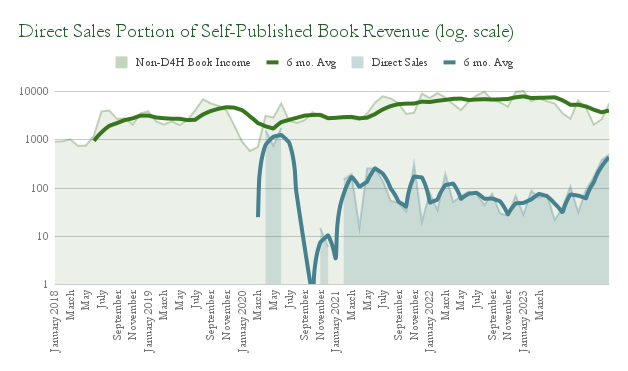
This wasn’t a record in direct sales, since that would include when I sold the Preview Edition of MMT, through Payhip.
Reporting improvements
I also finally found a good report on which to track my revenue. It’s the “Sales by product variant SKU” report.
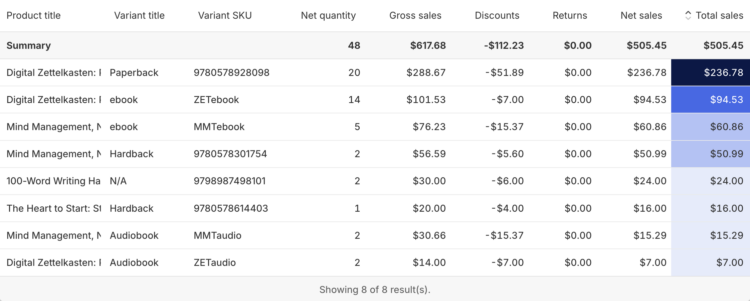
Unfortunately, I still haven’t gotten any good reporting from BookVault. I emailed with them a bit and they’ve been mildly responsive, but I haven’t gotten what I’ve requested.
For the meantime, I’m cross-referencing data from this Product Variant SKU report with a spot-check of what it cost me per-unit to print each particular book that month. That price is in pounds, so I’m also converting it to dollars, based upon the exchange rate at the beginning of the given month. So, I have a spreadsheet that gives me my Gross Margin for books sold direct for the month.
According to this spreadsheet, here are the average Gross Margins on paper books I sold directly in December:
- ZET: $10
- MMT: $16
- HWH: $12
- HTS: $8
Those margins aren’t necessarily reflective of typical Gross Margins. Some customers used discount codes.
I still don’t have a good way of determining what I spent on shipping. I guess I could take my BookVault balance from the beginning of the month, plus what I spent topping up BookVault, minus my balance at the beginning of the month, and subtract from that my estimated COGS from the spreadsheet. That would tell me what I spent on shipping, but it wouldn’t tell me how much shipping I gave away through free shipping promotions.
Readwise newsletter promotion
My direct sales were helped out a lot by a giveaway I did of Digital Zettelkasten on the Readwise newsletter.

This is a new newsletter by Readwise. When they approached me about giving away one of my books, I was initially reluctant. After much thought, I figured ZET was the perfect book for that audience, and since I love Readwise so much, and feel that it and the Zettelkasten method are two tools that make the world a better place through promoting thoughtful reading, it ultimately felt right.
On the whole, I think it was a good business decision, too. I saw a spike in ZET sales on Amazon.

And I also sold directly a large handful of paperbacks, as well as some ebooks, and one single audiobook.
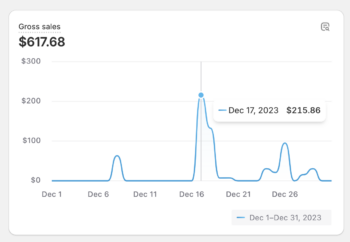
Even though people got the book for free to read on Readwise, some portion either wanted their preferred reading experience, or just wanted to say “thanks.”
I can’t link this promotion to an increase in sale of any of my other books, however, which is a bit surprising.
Facebook & Instagram stores now working
The more I play with Shopify, the more I see that they’ll be a data provider that injects products into and processes sales from various sales channels. For example, you can inject items from your store into Google Merchant Center or TikTok.
So far, I’ve been successful at using this method to set up my stores on Instagram and Facebook. Here’s a peek at my Instagram store, populated through Shopify.
This provides a native experience. Without leaving the app, users can buy directly from me. Those who do it habitually are used to the experience, and already have their payment information entered.
Work-around for rejected ebooks/audiobooks
Setting this up through Shopify is overall really easy, but there was one catch that made it really confusing. My products were being rejected because they don’t support electronic products, and my product feed included ebook and audiobook versions.
It took me a long time to realize that I could make copies of my products, remove all information regarding electronic versions, and only publish them to external stores, such as Meta, Google, and TikTok. Meanwhile, I could un-publish from the online store the versions of the product pages that didn’t include electronic variants.
This is a somewhat inelegant solution – I wish I could just un-publish the electronic variants from the third-party feeds – but, so far, it works. My products are being accepted by Meta stores. I still need to look into Google Merchant Center more, and my living internationally is making getting a TikTok store set up an ongoing challenge.
New hope for 100-Word Writing Habit?
I’ve mentioned before that 100-Word Writing Habit has thus far sold short of expectations. But I’m reluctant to call it a “flop,” because I’ve seen some people react to it really positively, and the reviews are good. I also have less to compare to, since there isn’t an ebook version, like there is for my other books.
I sense it’s more of a point-of-sale or impulse-buy book. It’s the kind of book you need to see in front of you, or buy as a gift for someone. I sold a copy of it at my live event in November, for example.
The book has also been selling pretty well through Meta ads. In fact, it’s outselling my other books through this channel by quite a bit. There have been short periods when I was even advertising it profitably! In any case, it’s refreshing to see it potentially find a home.
Trying 55% wholesale discount
I figured this would be a good opportunity to try out the oft-recommended 55% wholesale discount on the IngramSpark version. Supposedly this motivates retailers to stock your book, though you risk losing money on any returns.
I don’t know if that will be enough to get retailers to stock the book. But I think it would perform better at point-of-sale, so I’m giving it a shot. Unfortunately Ingram’s print quality isn’t as good as BookVault’s.
Mind Management 2023 in review
Mind Management, Not Time Management has now been out for three full calendar years. Here are some detailed numbers on the sales:
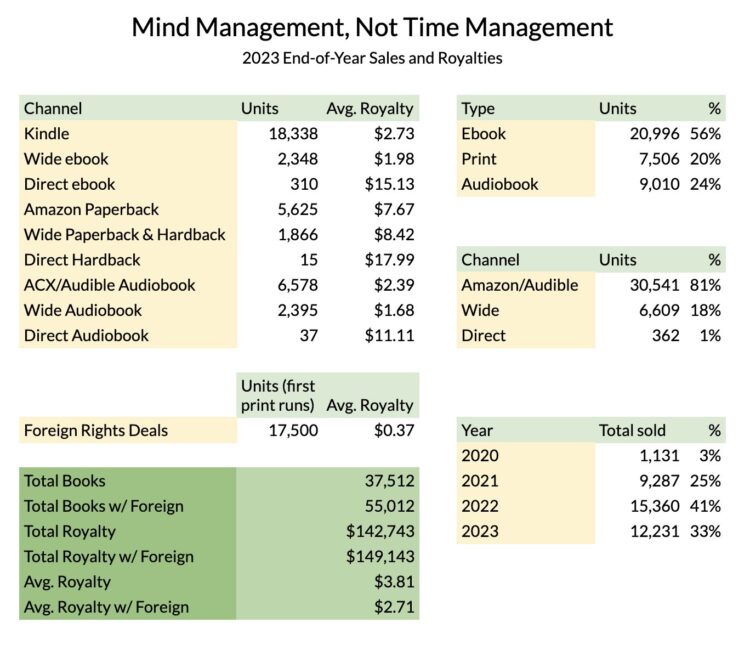
It’s surprising, looking back to see that the number of copies sold was lower in the first full year (2021) than the second. So sales peaked in the second full year, but pulled back in 2023.
However, I spent over $6,000 more on ads in 2022 than 2023. That amounted to a roughly 3,000-copy difference. While sales velocity has slowed, the profit margin has grown.
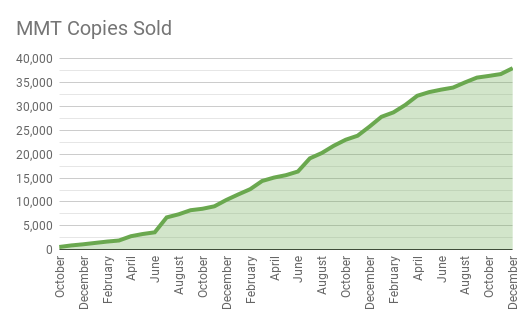

Again, I’m reminded I could probably earn more by spending a little more on ads.
HTS vs MMT sales velocity
As I search for motivation to finish Finish What Matters, it’s helpful to reflect on the sales velocity of MMT versus HTS, specifically, how the release of MMT appears to have lifted the profit margin of HTS.
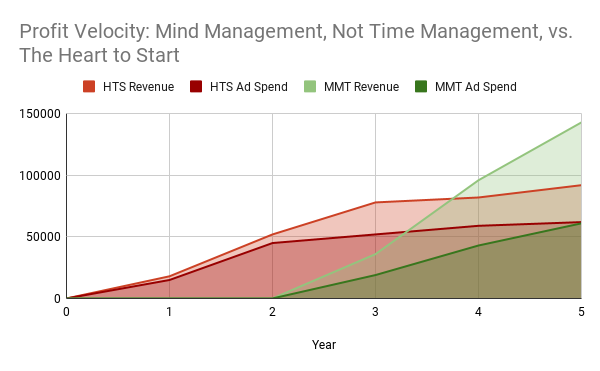
Notice I struggled to turn a profit with HTS until MMT came out. Notice also that MMT has grown in sales more rapidly and sustained organic profits.
I posit that completing the trilogy will lift sales and profit margins across all books. HTS is very close to breaking the 30,000-copy barrier, but perhaps after a couple years as part of a trilogy, it can break the forty or 50,000 copy barrier. MMT is at 38,000, and I’m very confident it can break 50,000 after a year of being a part of a trilogy.
500 India copies reported
I’ve received an email from the agent who arranged my India deal for MMT, who mentioned that the publisher’s first print run of 500 copies has sold, and they’re printing another batch. I have mentioned before that I have very little visibility into foreign sales, and am not sure how or whether to count them when I make a deal with a specified first print run. I have opted to only count the sales once they’ve been reported in some way. So, I have now accounted for these 500 copies in my overall MMT sales.
Mind Management BookBub Featured Deal
I have another BookBub Featured Deal for MMT. Starting on February 2nd, it will be marked down to $1.99.
I’m still feeling the sting from last spring, when I had a conflict between MMT being chosen for a Kindle Deal by Amazon, and a potential BookBub Featured Deal. I wound up going with the Featured Deal, which ruined my Kindle Deal. Unfortunately, MMT hasn’t been chosen for a deal in the U.S. since.
I also caved in my resolve to get MMT approved for a $2.99 deal. I have seen more $1.99 deals come through my inbox lately, so I decided to play along with the trend. Lo and behold, after a couple rejections at $2.99, it was accepted for a deal at $1.99.
The last Featured Deal I held, last April, sold close to 1,000 copies. The two previous deals sold about 1,700, and 2,700, respectively. I spent quite a bit on ads for those (I “lost” $1,300 on the first one), and they were also for a larger “Advice and How-To” category. It seems they now prefer to put the book in the smaller “Business” category (which may also be relatively new).
Income
Book Sales
| Mind Management, Not Time Management Kindle | $853 |
| Mind Management, Not Time Management Paperback (Amazon) | $2,244 |
| Mind Management, Not Time Management (non-Amazon) | $633 |
| Mind Management, Not Time Management Audiobook | $432 |
| 100-Word Writing Habit | $29 |
| Digital Zettelkasten Kindle | $569 |
| Digital Zettelkasten Wide (non-Kindle) | $570 |
| Digital Zettelkasten Audiobook | $40 |
| The Heart to Start Kindle | $152 |
| The Heart to Start Paperback (Amazon) | $139 |
| The Heart to Start “Wide” (non-Amazon) | $37 |
| The Heart to Start Audiobook | $18 |
| How to Write a Book Kindle | $14 |
| How to Write a Book Paperback | $51 |
| How to Write a Book “Wide” (non-Amazon) | $0 |
| How to Write a Book Audiobook | $12 |
| How to Write a Book Spanish (all) | $7 |
| Make Money Writing on the STEEM Blockchain (all) | $0 |
| Ten Passive Income Ideas | $3 |
| Total Book Sales | $5,804 |
Digital Products
| Summer of Design | $27 |
| Total Digital Products | $27 |
Affiliates / Advertising
| Active Campaign | $320 |
| Alliance of Independent Authors | $71 |
| Amazon | $33 |
| Google AdSense | $118 |
| Hostgator | $100 |
| SendOwl | $5 |
| Total Affiliates | $648 |
Reader Support
| Patreon | $152 |
| Total Reader Support | $152 |
Services
| Clarity | $0 |
| Medium | $0 |
| Total Services | $0 |
| GROSS INCOME | $6,631 |
Expenses
General
| Accounting | $0 |
| Book Printing | $255 |
| Outside Contractors | $0 |
| Quickbooks | $27 |
| Total General | $282 |
Advertising
| Amazon | $692 |
| BookBub | $0 |
| Meta | $0 |
| Influencer Marketing | $899 |
| Product Samples | $0 |
| Total Advertising | $1,591 |
Hosting
| ActiveCampaign | $135 |
| Bookfunnel | $15 |
| Drafts | $2 |
| Dropbox | $10 |
| Fathom Analtyics | $14 |
| Libsyn | $5 |
| Namecheap | $16 |
| Obsidian Publish | $10 |
| SendOwl | $9 |
| Shopify | $5 |
| Ulysses | $3 |
| WP Engine | $96 |
| Zapier | $14 |
| Total Hosting | $334 |
| TOTAL EXPENSES | $2,207 |
| NET PROFIT | $4,424 |




